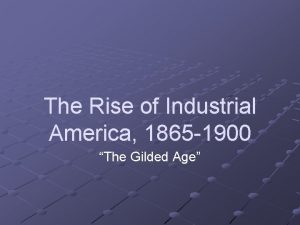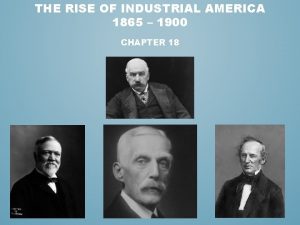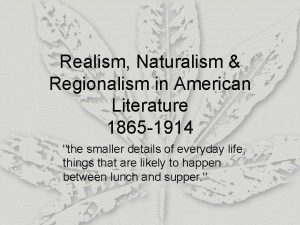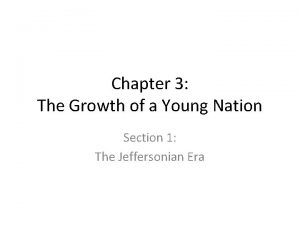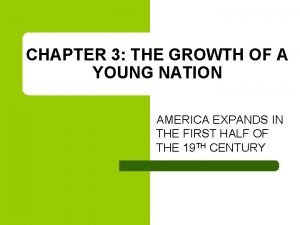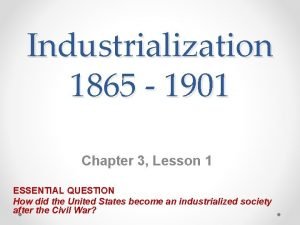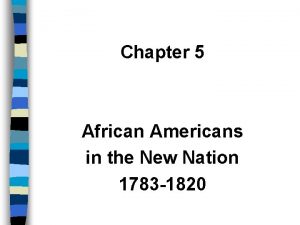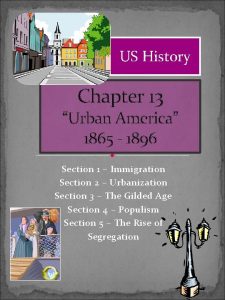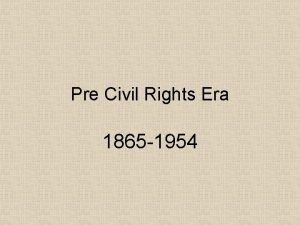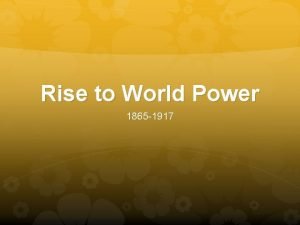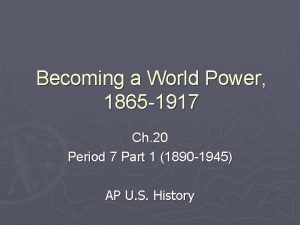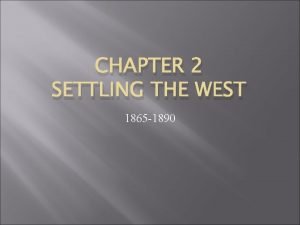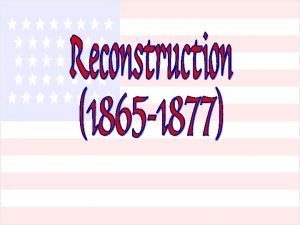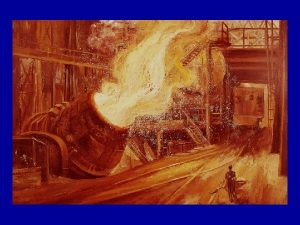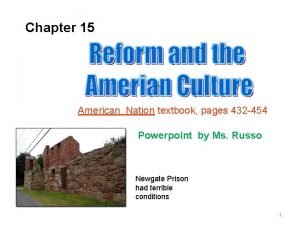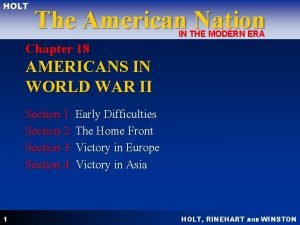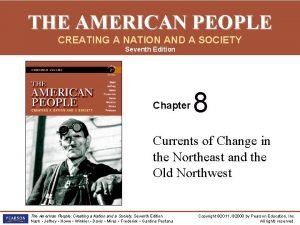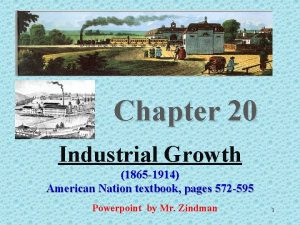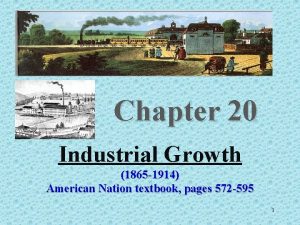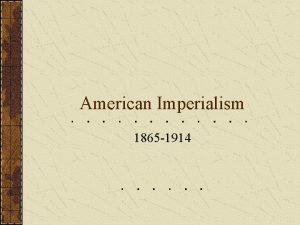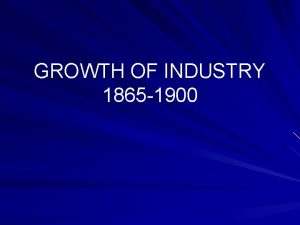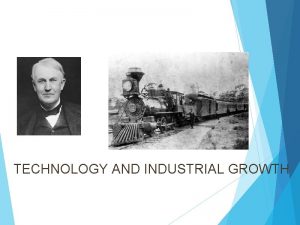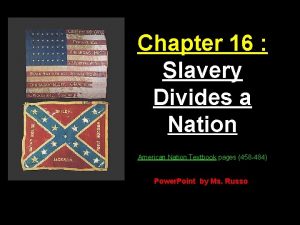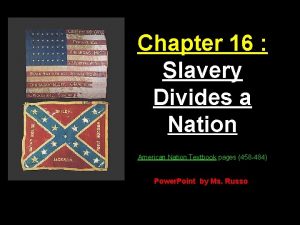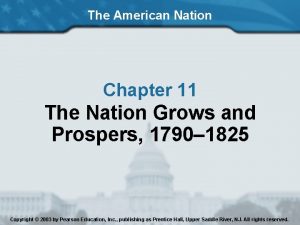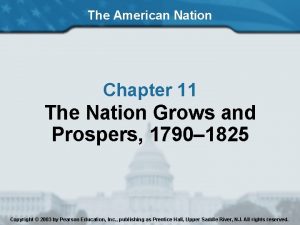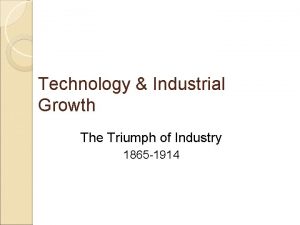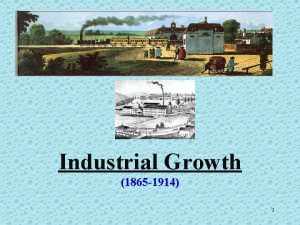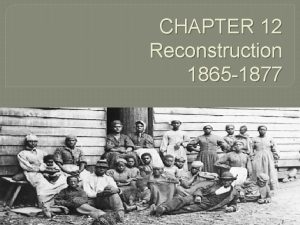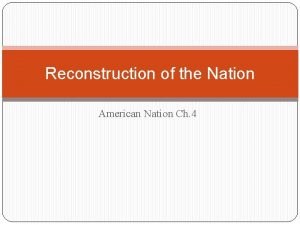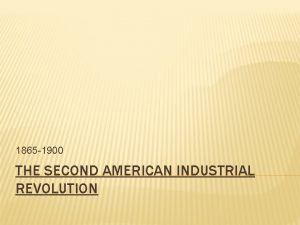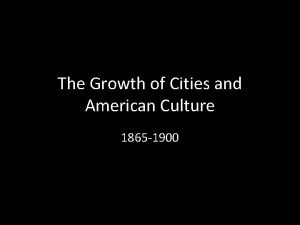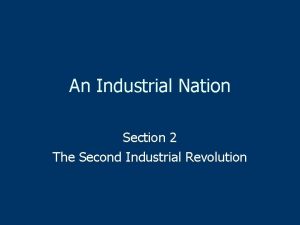The American Nation Chapter 20 Industrial Growth 1865
































- Slides: 32

The American Nation Chapter 20 Industrial Growth, 1865– 1914 Copyright © 2003 by Pearson Education, Inc. , publishing as Prentice Hall, Upper Saddle River, NJ. All rights reserved.

The American Nation Chapter 20: Industrial Growth, 1865– 1914 Section 1: Railroads Spur Industry Section 2: The Rise of Big Business Section 3: Inventions Change the Nation Section 4: The Rise of Organized Labor Copyright © 2003 by Pearson Education, Inc. , publishing as Prentice Hall, Upper Saddle River, NJ. All rights reserved.

Railroads Spur Industry Chapter 20, Section 1 • What factors led to the construction of a network of railroads after the Civil War? • How did railroad executives eliminate competition? • How did railroad building encourage the growth of the American economy?

Factors That Contributed to a Railroad Boom Chapter 20, Section 1 Standardized track Early railroads were short, local lines. They used tracks of different gauges, or widths. Therefore, trains from one line could not run on the tracks of another line. In 1886, most railroads adopted the same gauge. That allowed American railroads to join together in a network, or system of connected lines. New inventions helped make railway travel safer and faster. • George Westinghouse invented the air brake, which allowed an engineer to stop all the railroad cars at once. • George Pullman designed a railroad sleeping car. Pullman cars had convertible berths for sleeping as well as lavatories. • Rail lines added dining cars.

Factors That Contributed to a Railroad Boom Chapter 20, Section 1 Consolidation To operate railroads more efficiently, companies began to consolidate, or combine. Larger companies bought smaller companies. Cornelius Vanderbilt used ruthless tactics to buy up most of the rail lines between Buffalo and Chicago. New rail lines Companies raced to create thousands of miles of new tracks. After the first transcontinental rail line in 1869, railroad companies built three more transcontinental lines. James Hill completed the last one—the Great Northern

Eliminating Competition Chapter 20, Section 1 With the overbuilding of rail lines in some parts of the country, railroad companies looked for ways to outdo or get rid of the competition—especially in the West. • Railroads granted secret rebates, or discounts, to their biggest customers. This practice forced many small companies out of business. It also hurt small farmers, who had to pay higher rates. • Railroad owners looked for ways to end competition, including pooling. In a pool, several railroad companies agreed to divide up the business in an area. Then, they fixed shipping prices at a high level. Reaction to rebates and pools • Rebates and pools angered small farmers in the South and the West. Both practices kept shipping prices high for them. • Many farmers joined the Populist party. The party called for government regulation of rail rates. • Congress did pass laws regulating railroad companies, but the laws did not end abuses.

Railroads Contribute to the Growth of the American Economy Chapter 20, Section 1 • The building of rail lines created thousands of jobs for steelworkers, lumberjacks, miners, and railroad employees. • The large railroads pioneered new ways of managing business, such as having separate shipping, accounting, and service departments. Other big businesses soon copied these management techniques. • Railroads opened every corner of the country to settlement and growth.

Section 1 Assessment Chapter 20, Section 1 Railroad companies were able to form a network of rail lines across the nation because a) loggers cut down whole forests that were in the way of railroad building. b) railroads standardized the size of the track they used. c) many short lines served only local communities. d) northern lines and southern lines had different kinds of track. Small farmers in the South and the West called for the government to regulate railroads because a) railroad building gave jobs to miners and lumberjacks but not to farmers. b) the noise of air brakes was frightening livestock along the track. c) rather than competing for customers, railroads were dividing up the business in an area, then fixing high shipping rates. d) James Hill was encouraging some farmers and ranchers to settle near his railroad by helping them buy equipment. Want to connect to the American History link for this section? Click here.

Section 1 Assessment Chapter 20, Section 1 Railroad companies were able to form a network of rail lines across the nation because a) loggers cut down whole forests that were in the way of railroad building. b) railroads standardized the size of the track they used. c) many short lines served only local communities. d) northern lines and southern lines had different kinds of track. Small farmers in the South and the West called for the government to regulate railroads because a) railroad building gave jobs to miners and lumberjacks but not to farmers. b) the noise of air brakes was frightening livestock along the track. c) rather than competing for customers, railroads were dividing up the business in an area, then fixing high shipping rates. d) James Hill was encouraging some farmers and ranchers to settle near his railroad by helping them buy equipment. Want to connect to the American History link for this section? Click here.

The Rise of Big Business Chapter 20, Section 2 • What factors were responsible for the growth of huge steel empires after the Civil War? • What benefits did corporations and bankers provide to the growing economy? • How did John D. Rockefeller amass his huge oil holdings? • What were the arguments for and against trusts?

The Growth of the Steel Industry Chapter 20, Section 2 Bessemer process • In the 1850 s, William Kelly in the United States and Henry Bessemer in England each discovered a new way to make a strong steel at a low cost. This way of making steel came to be called the Bessemer process. Steel mills • Steel mills sprang up in cities throughout the Midwest. Pittsburgh became the steel-making capital of the nation. The steel boom brought jobs and prosperity. It also caused problems, such as polluted water and air. Andrew Carnegie • Andrew Carnegie began with one steel mill, then used his profits to buy out rivals. He also bought iron mines, railroad and steamship lines, and warehouses. Soon he controlled all phases of the steel industry from mining iron ore to shipping finished steel. Gaining control of all the steps used to change raw materials into finished products is called vertical integration.

Corporations and Bankers Chapter 20, Section 2 • • By the late 1800 s, big factories were producing goods more cheaply than small factories. To expand, big factories needed capital, or money, for investment in raw materials, workers’ pay, and shipping and advertising costs. Many expanding businesses became corporations—businesses owned by investors. • A corporation sells stock, or shares in the business, to investors, who are known as stockholders. • In return for their investment, stockholders hope to receive dividends, or shares of a corporation’s profit. Corporations also raised money by borrowing millions of dollars from banks. These loans helped American industry grow at a rapid pace. The most powerful banker of the late 1800 s was J. Pierpont Morgan. He used his banking profits to gain control of major corporations. By 1901, he had become the head of the United States Steel Company, the first American business worth more than $1 billion.

John D. Rockefeller’s Oil Empire Chapter 20, Section 2 • • • In 1859, drillers near Titusville, Pennsylvania, made the nation’s first oil strike. John D. Rockefeller recognized that oil had little economic value until it was refined to make kerosene. He built an oil refinery. Rockefeller believed that competition wasteful. He used his profits to buy up other refineries. He combined the companies into the Standard Oil Company. He did whatever he could to get rid of competition. He slashed prices so others could not compete, pressured customers not to deal with other companies, and forced railroads to grant rebates to Standard Oil. Rockefeller formed the Standard Oil trust—a group of corporations run by a single board of directors. Stockholders in smaller oil companies turned over their stock to Standard Oil. In return, they got stock in the new trust. The Standard Oil board of directors managed all the companies that used to be the competition. Standard Oil trust had created a monopoly of the oil industry. A monopoly controls all or nearly all the business of an industry.

Arguments For and Against Trusts Chapter 20, Section 2 In a free enterprise system, businesses are owned by private citizens. Private citizens decide what to make, how much to produce, where to sell, and what to charge. Some Americans said large corporations hurt the free enterprise system. The Argument Against Trusts • Trusts and monopolies reduce competition. Without competition, there is no need to keep prices low or improve products. • New companies can’t compete with powerful trusts. • Trusts have too much political influence. They are able to buy favors from elected officials. The Argument in Favor of Trusts • Competition can ruin businesses and put people out of work. • The wealthy contribute the most to the community. • Corporations bring lower production costs, lower prices, higher wages, and a better quality of life for all. • By 1900, Americans had the highest standard of living in the world. In 1890, Congress passed the Sherman Antitrust Act, banning the formation of trusts and monopolies. However, the law was too weak to be effective.

The Growth of American Business • Steel and oil become giant industries • Monopolies and trusts dominate important industries • Factory workers face harsh conditions • Membership in labor unions grows Effects Today Effects • Railroad boom spurs business • Businesses become corporations • Nation has rich supply of natural resources • New inventions make business more efficient The Rise of Industry Causes Chapter 20, Section 2 • United States is world’s leading economic power • American corporations do business around the world • Government laws regulate monopolies

Section 2 Assessment Chapter 20, Section 2 A corporation is a business that a) is owned by several small businesses that make the same product. b) controls all the steps used in changing a raw material into a finished product. c) controls all or nearly all the business in a single industry. d) is owned by investors who have bought shares of the business, hoping for a share of the profits. One argument against trusts is that a) they discourage competition, which results in higher prices. b) too much competition ruins businesses. c) they spread the profits out among too many people. d) they are too efficient and put people out of work. Want to connect to the American History link for this section? Click here.

Section 2 Assessment Chapter 20, Section 2 A corporation is a business that a) is owned by several small businesses that make the same product. b) controls all the steps used in changing a raw material into a finished product. c) controls all or nearly all the business in a single industry. d) is owned by investors who have bought shares of the business, hoping for a share of the profits. One argument against trusts is that a) they discourage competition, which results in higher prices. b) too much competition ruins businesses. c) they spread the profits out among too many people. d) they are too efficient and put people out of work. Want to connect to the American History link for this section? Click here.

Inventions Change the Nation Chapter 20, Section 3 • What new devices speeded up communications after the Civil War? • How did Thomas Edison and other inventors bring new technologies to Americans at work and at home? • What changes did the automobile and the airplane make in American life?

New Devices Speeded Up Communications Chapter 20, Section 3 A flood of invention swept the United States in the late 1800 s. Between 1870 and 1900, the federal government issued more than 500, 000 new patents— licenses for new inventions. Inventions improve communications. Telegraph Speeded up communication within the United States. Transatlantic cable Cyrus Field had the idea of laying a cable under the ocean so that telegraph messages could go back and forth from one country to another. In 1858, Britain’s Queen Victoria sent the first transatlantic, or across the Atlantic, message. Telephone Alexander Graham Bell’s “talking machine” did not interest people much at first. By 1885, Bell formed his own company and sold more than 300, 000 phones. With the telephone, the pace of business speeded up even more. People no longer had to go to a telegraph office.

Thomas Edison and Other Inventors Chapter 20, Section 3 New inventions and ideas made business more efficient and life easier. Thomas Edison • He used a system where teams of experts refined his ideas. • His workshop invented the light bulb, phonograph, and first motion picture projector. • The power plant was one of Edison’s most important creations. Soon factories replaced steam-powered engines with safer, quieter, electric engines. Gustavus Swift • Meatpacking plant and the use of refrigerated railroad cars to ship fresh meat Christopher Sholes • Typewriter; speeded up communication between businesses George Eastman • Lightweight camera; photography became popular Elijah Mc. Coy • Device that oiled engines automatically Granville T. Woods • A way to send telegraph messages between moving trains Jan Matzeliger • A machine that performed almost all steps in making shoes

Inventors Chapter 20, Section 3 Date 1852 1864 1869 1872 1873 1874 1876 1877 1878 1879 1883 1884 1887 1893 1895 1899 1909 Inventor Elisha Otis George Pullman George Westinghouse Elijah Mc. Coy Andrew S. Hallidie Stephen Dudley Field Alexander Graham Bell Thomas Alva Edison Anna Baldwin Thomas Alva Edison James Ritty Jan E. Matzeliger Lewis E. Waterman Granville T. Woods Charles and J. Frank Duryea King C. Gillette John Thurman Leo H. Baekeland Invention Passenger elevator brake Sleeping car Air brake Automatic engine-oiling machine Cable streetcar Electric streetcar Telephone Phonograph Milking machine First practical incandescent light bulb Cash register Shoemaking machine Fountain pen Automatic air brake Gasoline-powered car Safety razor with throwaway blades Motor-driven vacuum cleaner Improved plastic

The Automobile and the Airplane Change American Life Chapter 20, Section 3 In 1913, Henry Ford introduced the moving assembly line. • Workers stay in one place as products edge past them on a moving belt. • The assembly line reduced the time needed to build a car. • The assembly line allowed mass production—the making of large quantities of a product quickly and cheaply, which meant lower prices. Reaction to the automobile • At first, people laughed at the automobile. Some thought it was a nuisance. Others thought it was dangerous. • Automobiles gave people freedom to travel easily. • Eventually automobiles would make travel quicker and trade easier. On December 17, 1903, Orville and Wilbur Wright made the first flight. • The first flights did not attract much interest. No one could see any use for a flying machine. • The United States military first saw a use for airplanes. They could fly over battlefields to locate enemy positions.

Section 3 Assessment Chapter 20, Section 3 Thomas Edison was able to file thousands of patents because he a) sold his ideas through Western Union. b) set up a laboratory in which teams of experts worked out his ideas. c) tried over and over again to find a way to send messages across the Atlantic. d) bribed patent officials. One advantage of the moving assembly line was that a) it reduced the time needed to make something. b) assembly line workers were never bored. c) it raised prices, therefore companies brought in more money. d) it meant that one worker could make a thing from start to finish. Want to connect to the American History link for this section? Click here.

Section 3 Assessment Chapter 20, Section 3 Thomas Edison was able to file thousands of patents because he a) sold his ideas through Western Union. b) set up a laboratory in which teams of experts worked out his ideas. c) tried over and over again to find a way to send messages across the Atlantic. d) bribed patent officials. One advantage of the moving assembly line was that a) it reduced the time needed to make something. b) assembly line workers were never bored. c) it raised prices, therefore companies brought in more money. d) it meant that one worker could make a thing from start to finish. Want to connect to the American History link for this section? Click here.

The Rise of Organized Labor Chapter 20, Section 4 • How did workplace changes lead to the rise of labor organizations such as the American Federation of Labor? • What progress and problems affected women in the workplace during the late 1800 s? • Why did organized labor face hard times after 1870?

The Rise of Labor Organizations Chapter 20, Section 4 The problems workers faced The workplace Before the late 1800 s, factories were small and family run. By the late 1800 s, factories had become large, crowded, and noisy. Wages were low. In some industries, sweatshops became common. A sweatshop is a workplace where people labor long hours in poor conditions for low pay. Child labor In 1900, nearly 2 million children under age 15 worked. Many worked in mills, tobacco factories, garment sweatshops, and coal mines. They had little chance to go to school. Hazards of work The workplace could be dangerous. For example, the air in textile mills was unhealthy and dust filled. Cave-ins and explosions occurred in mines. Vats of molten metal spilled in steel mills.

The Rise of Labor Organizations Ways workers fought back Chapter 20, Section 4 Knights of Labor • In 1869, workers formed the Knights of Labor. At first, the union was open to skilled workers only. • Knights of Labor president Terence Powderly worked to open the union to immigrants, African Americans, women, and unskilled workers. • Knights goals included a shorter workday, an end to child labor, and equal pay for men and women. • Powderly wanted workers and employers to share ownership and profits. Haymarket Square • Workers at the Mc. Cormick Harvester Company went on strike. The Knights did not support the strike. • The Mc. Cormick Company hired strikebreakers, or replacements for striking workers. • Workers clashed with strikebreakers. Police opened fire, killing four workers. • The next day, anarchists, people who oppose all organized government, led a rally in Haymarket Square. • A bomb exploded, killing seven police officers. • Eight anarchists were arrested for what was called the Haymarket Riot. Antilabor feeling swept the nation.

The Rise of Labor Organizations Chapter 20, Section 4 American Federation of Labor • In 1886, Samuel Gompers organized the American Federation of Labor (AFL), for skilled workers only. • Workers joined a trade union, a union of persons in the same trade, and the union then joined the AFL. • The AFL worked for higher wages, shorter hours, improved working conditions, and collective bargaining, the right of unions to negotiate with management on behalf of workers. • African Americans, immigrants, and unskilled workers were barred from trade unions, and thus, the AFL.

Women in the Workplace Chapter 20, Section 4 Women worked for better conditions, too. Mother Jones Mary Harris Jones devoted much of her life to the cause of workers. By calling attention to abuses, she helped pave the way for reform. International Ladies’ Garment Workers Union (ILGWU) In 1900, garment workers organized the ILGWU, which went on strike for better conditions. More than 20, 000 women and men walked off their jobs. After a few weeks, employers met demands for better pay and shorter hours. Triangle Fire In 1911, fire broke out in the Triangle Shirtwaist Factory in New York City. Nearly 150 people, mostly young women, died because the company had locked the doors to keep workers at their jobs. Their deaths shocked the public and led New York and other states to approve new safety laws to protect factory workers.

Organized Labor Falls on Hard Times Chapter 20, Section 4 • • • Between 1870 and 1900, two major depressions and three recessions rocked the country. In such hard times, workers lost jobs or experienced pay cuts. In the 1870 s railroad workers went on strike. In some places, the strikes turned into riots. In the 1870 s and the 1890 s, miners organized strike after strike. The federal government usually sided with business owners. Some Presidents sent in troops to end the strikes. Courts usually ruled against the strikers. In one case, Pullman workers were jailed for violating the Sherman Antitrust Act. This act was intended to keep trusts from limiting free trade. The courts, however, said that the strikers were limiting free trade. Union workers staged thousands of strikes during the late 1800 s. However, few Americans supported the strikes. Many feared that unions were run by foreign-born radicals.

Section 4 Assessment Chapter 20, Section 4 The AFL worked for collective bargaining, which means a) people working together to organize informal strikes. b) a union organizing strikes against two different industries at the same time. c) equal pay for men and women. d) the right of unions to negotiate with management on behalf of workers. In the late 1800 s, in conflicts between factory owners and workers, the federal government usually a) sided with the workers. b) sided with the factory owners. c) tried to help but not take sides. d) refused to get involved at all. Want to connect to the American History link for this section? Click here.

Section 4 Assessment Chapter 20, Section 4 The AFL worked for collective bargaining, which means a) people working together to organize informal strikes. b) a union organizing strikes against two different industries at the same time. c) equal pay for men and women. d) the right of unions to negotiate with management on behalf of workers. In the late 1800 s, in conflicts between factory owners and workers, the federal government usually a) sided with the workers. b) sided with the factory owners. c) tried to help but not take sides. d) refused to get involved at all. Want to connect to the American History link for this section? Click here.
 The rise of industrial america 1865-1900
The rise of industrial america 1865-1900 The rise of industrial america 1865-1900
The rise of industrial america 1865-1900 Realism v naturalism
Realism v naturalism Chapter 3 the growth of a young nation
Chapter 3 the growth of a young nation Chapter 3 the growth of a young nation
Chapter 3 the growth of a young nation Industrialization (1865 to 1901 worksheet answers key)
Industrialization (1865 to 1901 worksheet answers key) Chapter 5 african american in the new nation
Chapter 5 african american in the new nation American nation chapter 4
American nation chapter 4 American nation chapter 4
American nation chapter 4 Country vs nation
Country vs nation Nation state vs nation
Nation state vs nation State vs nation
State vs nation Urban america 1865 to 1896
Urban america 1865 to 1896 St helen’s smelting co v tipping (1865)
St helen’s smelting co v tipping (1865) 1954-1865
1954-1865 Becoming a world power 1865-1917
Becoming a world power 1865-1917 Impressionism characteristics
Impressionism characteristics Becoming a world power 1865-1917
Becoming a world power 1865-1917 Settling the west 1865 to 1890
Settling the west 1865 to 1890 Al cruzar una planta de guisantes de flores purpura
Al cruzar una planta de guisantes de flores purpura Impressionism characteristics
Impressionism characteristics Whats the compromise of 1877
Whats the compromise of 1877 Industrialization (1865 to 1901 worksheet answers key)
Industrialization (1865 to 1901 worksheet answers key) 1865 to 1900 inventions
1865 to 1900 inventions American nation textbook
American nation textbook Holt american nation
Holt american nation The american people creating a nation and a society
The american people creating a nation and a society What is growth analysis
What is growth analysis Eudicot
Eudicot Step growth polymerization vs chain growth
Step growth polymerization vs chain growth Primary growth and secondary growth in plants
Primary growth and secondary growth in plants Primary growth and secondary growth in plants
Primary growth and secondary growth in plants Geometric vs exponential growth
Geometric vs exponential growth
